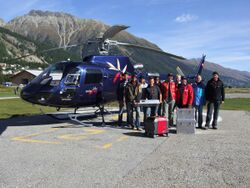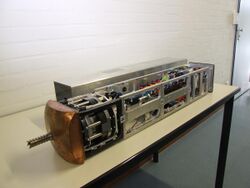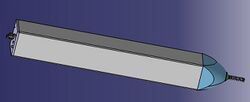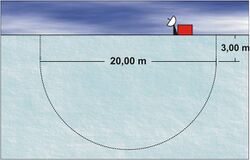Engineering:IceMole
IceMole is an autonomous ice research probe, incorporating a new type of ice-melting tip for the exploration of polar regions, glaciers, ice sheets, and extraterrestrial regions, developed by a team from the FH Aachen, a Fachhochschule (university of applied sciences) in Aachen, Germany . The advantage over previous probes is that the IceMole can change its direction and can be recovered after being used. A driving ice screw allows the probe to drill through soil layers and other contaminations in the ice.
History
The IceMole is being developed using rapid prototyping. (As of April 2011), the probe is in its first prototype and it has been designed to carry out the subsurface investigation of terrestrial glaciers and ice sheets. It is planned that future versions of the probe would be suitably adapted for extraterrestrial ice research, e.g. on the polar caps of Mars, Jupiter's moon Europa, or Saturn's moon Enceladus.[1]
The robot resulted from a student project at the Fachbereich Luft- und Raumfahrttechnik (Faculty of Aerospace Engineering) at the FH Aachen, led by Prof. Dr. Bernd Dachwald.[2][3] The excavation is carried out by both drilling and melting of the ice. In a clean ice core, the probe can analyze the surrounding ice with measuring instruments.[3] While drilling, the surrounding ice is not biologically contaminated.[2]
(As of 2011), the project objectives are given as:[3]
- Terrestrial applications
- In 2–3 years: in glaciers and ice sheets
- In 4–6 years: In the ice and the subglacial lakes in Antarctica
- Extra Terrestrial applications
The project requirements also emphasised the need for maximum reliability, robustness, mobility, environmental security and autonomy.[3]
IceMole 1
Heated tips in probes have been employed since the 1960s but the probes could only drill straight down, could not be recovered from deep intrusions and were halted by buildup of dirt and sediment, which would not permit heat transfer. To overcome these problems, the IceMole combines a screw with a melting tip.[1]
The first prototype IceMole is a pencil-shaped craft that is designed to autonomously deploy and dig itself into ice. It is a square tube of 225 cm2 (34.9 sq in) cross section. It has a 3 kW (4.0 hp) melting head at the tip which has differential heating in different parts. The robot is powered by a power generator on the surface and is attached by means of a cable, which relays the power supply, communication and data signals. The IceMole utilizes a 6 cm (2.4 in) long screw at its heated head that keeps firm contact while drilling with the ice being melted. The IceMole has separately controllable heating elements that can be manipulated to obtain differential heating. The differential heating permits the gradual change of direction.[1][2][3]
The ice screw is located at the tip of the melting head and generates a driving force that presses the melting head against the ice. This enables the IceMole to penetrate soil and mud and also leads to a good conductive heat transfer when in contact with the ice. The thermally isolated ice screw transfers ice into the probe, where it can be analyzed in situ. It is planned that instruments will be fitted in the probe that will analyse the ice and send only the results to the surface.[1][2]
The technical specifications of IceMole1 are given below :
- Melting velocity: max. 0.3 m (1 ft 0 in)/hour
- Heating elements: 4 × melting head
- Performance heating elements: the 2,200 W (3.0 hp)
- Average thermal power: 1,000 W (1.3 hp)
- Drive motor power: 25 W (0.034 hp)
- Weight: 30 kg (66 lb)
- External dimensions: 150 mm (5.9 in) x 150 mm (5.9 in) x 870 mm (34 in)
- Payload: on-board digital camera
The IceMole team has developed the vehicle without a specific payload in mind. The vehicle has an inner chamber in which sensors and other instruments may be housed. In its recent tests,[when?] the IceMole carried an off-the-shelf camera. The team is also designing a fluorescence biosensor detector that could search for organic molecules in the ice.[1][2]
IceMole 2
Since October 2010, the IceMole team is working on a redesign of the first IceMole. The Improvements are, amongst others, the optimization of the melting head and a completely newly developed gear. The new melting head has 12 separately controlled heating elements. These 12 cartridge heaters are arranged in a ring inside of the melting head. In addition, it has 2 wall heaters on each side in the rear of the probe. With this addition, the IceMole2 maneuverability improves over that of its predecessor. The new gear has been specially developed for this probe. Thus, the transmission has a higher efficiency and is more lightweight. It is planned to test IceMole2 in the summer of 2012.[2]
The planned technical specifications of IceMole2:[citation needed]
- Melting velocity: max. 1 m (3 ft 3 in)/hour
- Heating elements: 12 × melting head, 2x each side wall
- Heating Power head: max. 2,400 W (3.2 hp)
- Heating Power each side wall: max. 600 W (0.80 hp)
- Drive motor power: 25 W (0.034 hp)
- Weight: 25 kg (55 lb)
- External dimensions: 150 mm (5.9 in) x 150 mm (5.9 in) x 1,200 mm (47 in)
- Payload: fluorescence biosensor
The probe has also been designed to drag a series of containers containing sensors which can be jettisoned on command and deployed permanently in specific locations in the ice. The team hopes to eventually work with other researchers that would use IceMole to drop sensors deep in icy environments. While the power supply for the first field trials on a glacier was provided by an external power generator on the surface, it is also planned that the heating power be provided by an on-board power source.[1][3]
Trials
The first field trials were carried out in the area of the Morteratsch Glacier in Switzerland during the summer of 2010. During the trials on the glacier, the following penetration tests have been successfully performed:[1]
- melting 45° upwards for 1.5 m (4 ft 11 in) against gravity;
- melting horizontally for 5 m (16 ft);
- melting 45° downwards for 3 m (9.8 ft), thereby penetrating three obstructing non-ice layers (mud and sand found on the glacier) and driving a curve with a radius of 10 m (33 ft).
While IceMole moved at a leisurely 30 cm (12 in) per hour during its first trial run, optimal conditions could allow the craft to progress at more than three times that speed. The penetration speed will be increased for the next prototype.[1][2]
The test results show that the IceMole concept is a viable approach to deliver scientific instruments into deep ice and to recover them afterwards. Another advantage of the IceMole with respect to drilling is that biological contamination can be minimized and the process can be made highly autonomous, so that there is no need for an operator on the surface.[1][2]
The results were reported at the 2011 Antarctic Science Symposium in Madison, Wisconsin and the European Geosciences Union 2011 held at Vienna, Austria.[2] The next trial run was scheduled to be held in the Northern Hemisphere summer of 2012.[2]
The planned objectives for the field experiment in 2012 are given below.[citation needed]
1.)To demonstrate the recoverability of IceMole and its payloads
2.)To dig a horizontal "U"
3.)To dig a vertical "U"
4.)To travel distance of ~ 40 m
5) To function for durations of 50 - 150 hours
Blood Falls test
Blood Falls was used as the target for testing IceMole in November 2014. This unusual flow of melt water from below the glacier gives scientists access to an environment they could otherwise only explore by drilling (which would also risk contaminating it). Its source is a subglacial pool, of unknown size, which sometimes overflows. Biogeochemical analysis shows that the water is marine in source originally. One hypothesis is that its source may be the remains of an ancient fjord that occupied the Taylor valley in the tertiary period. The ferrous iron dissolved in the water oxidizes as the water reaches the surface, turning the water blood red.[4]
The test returned a clean subglacial sample from the outflow channel from Blood Falls.[5]
Subglacial environments in Antarctica need similar protection protocols to interplanetary missions,[6] and the probe was sterilized to these protocols using hydrogen peroxide and UV sterilization. Also, only the tip of the probe sampled the liquid water directly.[4][7]
See also
- Engineering:Autonomous underwater vehicle – Unmanned underwater vehicle with autonomous guidance system
- Engineering:BRUIE – Autonomous underwater vehicle
- Engineering:DEPTHX – Autonomous underwater vehicle for exploring sinkholes in Mexico
- Physics:Radioisotope thermoelectric generator – Electrical generator that uses heat from radioactive decay
References
- ↑ 1.0 1.1 1.2 1.3 1.4 1.5 1.6 1.7 1.8 Dachwald, Bernd; Changsheng Xu; Feldmann, Marco; Plescher, Engelbert (2011). "Development of a Novel Subsurface Ice Probe and Testing of the First Prototype on the Morteratsch Glacier". Geophysical Research Abstracts (European Geosciences Union General Assembly 2011, Vienna, Austria (3 – 8 April 2011)) 13. http://meetingorganizer.copernicus.org/EGU2011/EGU2011-4943.pdf.
- ↑ 2.0 2.1 2.2 2.3 2.4 2.5 2.6 2.7 2.8 2.9 Mann, Adam (30 April 2011). "The IceMole cometh - Novel design could help probe explore frozen environs on Earth and beyond". Nature News (Nature Publishing Group). doi:10.1038/news.2011.261. http://www.nature.com/news/2011/110430/full/news.2011.261.html.
- ↑ 3.0 3.1 3.2 3.3 3.4 3.5 IceMole team (1 May 2011). "The ice research probe IceMole (translated from German)". Students projects - Luft- und Raumfahrttechnik. Hochschule Aachhen. http://www.fb6.fh-aachen.de/lur/studienprojekte/icemole/.
- ↑ 4.0 4.1 Dachwald, Bernd; Mikucki, Jill; Tulaczyk, Slawek; Digel, Ilya; Espe, Clemens; Feldmann, Marco; Francke, Gero; Kowalski, Julia et al. (2014). "IceMole: a maneuverable probe for clean in situ analysis and sampling of subsurface ice and subglacial aquatic ecosystems". Annals of Glaciology 55 (65): 14–22. doi:10.3189/2014AoG65A004. ISSN 0260-3055. Bibcode: 2014AnGla..55...14D.
- ↑ Brabaw, Kasandra (7 April 2015). "IceMole Drill Built to Explore Saturn's Icy Moon Enceladus Passes Glacier Test". http://www.space.com/28930-icemole-drills-glacier-saturn-moon-enceladus.html.
- ↑ "SCAR's code of conduct for the exploration and research of subglacial aquatic environments". XXXIV Antarctic Treaty Consultative Meeting, Buenos Aires, June 20th - July 1st 2011. http://www.scar.org/scar_media/documents/science/atcm34_ip033_CofC_SAEs.pdf. ""7. Exploration protocols should also assume that the subglacial aquatic environments contain living organisms, and precautions should be adopted to prevent any permanent alteration of the biology (including introduction of alien species) or habitat properties of these environments.
28. Drilling fluids and equipment that will enter the subglacial aquatic environment should be cleaned to the extent practicable, and records should be maintained of sterility tests (e.g., bacterial counts by fluorescence microscopy at the drilling site). As a provisional guideline for general cleanliness, these objects should not contain more microbes than are present in an equivalent volume of the ice that is being drilled through to reach the subglacial environment. This standard should be re-evaluated when new data on subglacial aquatic microbial populations become available"" - ↑ ANDERSON, PAUL SCOTT (29 February 2012). "Exciting New 'Enceladus Explorer' Mission Proposed to Search for Life". http://www.universetoday.com/93879/exciting-new-enceladus-explorer-mission-proposed-to-search-for-life/.
External links
- Youtube coverage of the IceMole trial.
- Youtube time-lapse video of the IceMole Launch / Breakout.
- Website of Fachhochschule Aachen.
- Website of Prof. Dr. Bernd Dachwald, principal investigator
 |








